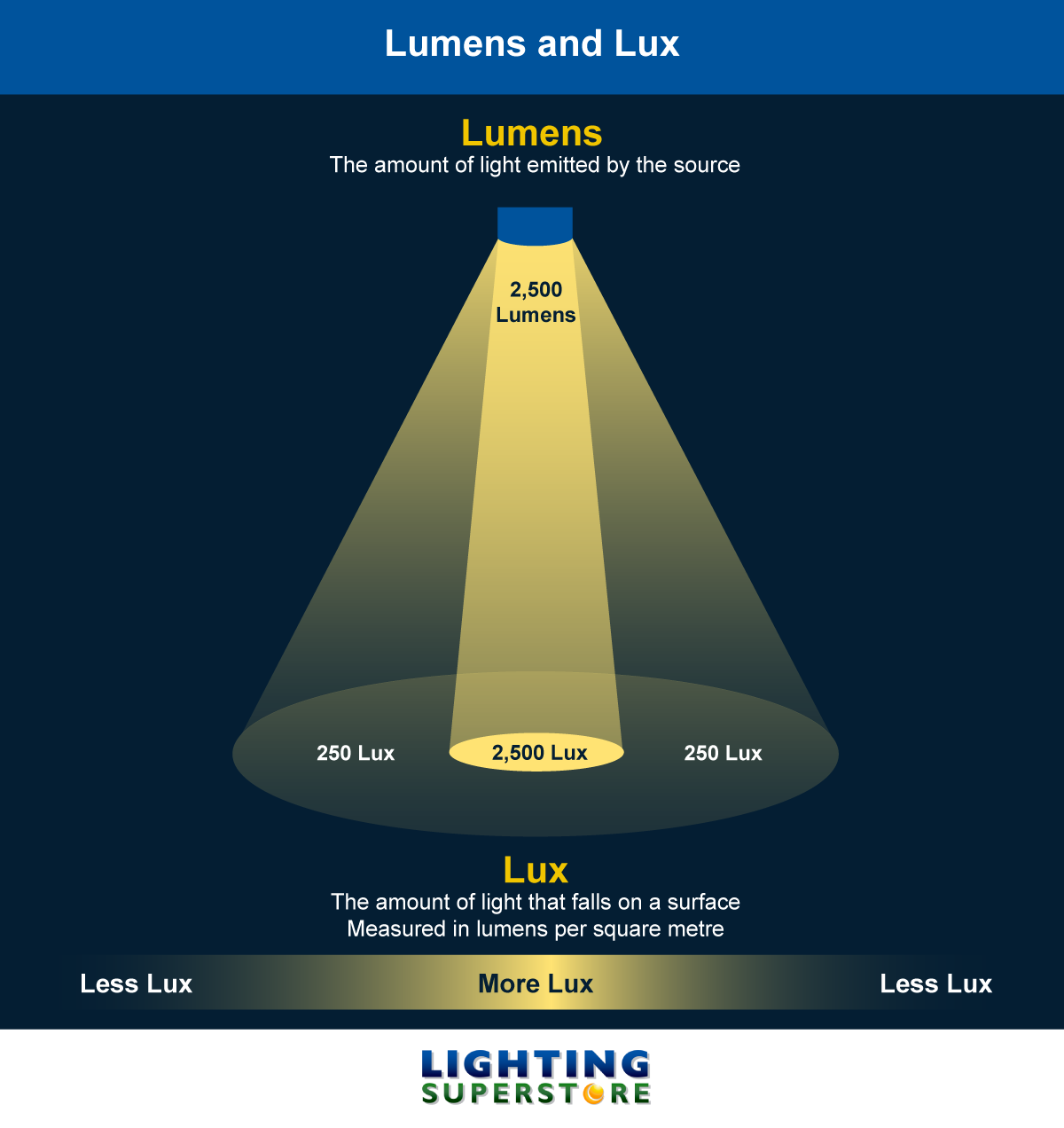Measuring Light: Guide to Lux and Lumens
While looking for light bulbs, you may have come across ‘lux’ and ‘lumens’ – but never really understood what exactly they are.
They are both used in measuring light, though they measure it in different ways. Our guide will help you understand more about lux and lumens, so you can shop for lights without any confusion.
What are lux and lumens?
In 2010, lumens (lm) started being used to measure light bulbs’ brightness instead of watts (W), which actually measure power. As light bulbs became more energy efficient, they used fewer watts, so wattage wasn’t an accurate measure of brightness anymore – so we switched to using lumens.
Lux and lumens are both units of measurement for brightness. They are used to tell us the amount of illumination output and intensity from a light source.
Lux (represented as lx) stands for luminous flux per unit area.
Lumens equals light output.
What is the difference between lux and lumens?
There is one key difference between the two:
-
Lux – measures illumination where light meets a surface. If you shine a torch on a wall, the point where the light meets the wall is measured in lux.
-
Lumens – measures the overall amount of light released by a source in all directions. This is known as ‘luminous flux.’

Each dot represents a unit of brightness that can be measured in both lux and lumens. Lumens are used to measure every dot that is dispersed from the light source. Lux measures the number of dots where they meet a surface.
Lux reading will be higher the closer the light source is to the surface, as opposed to lumens where distance or placement isn’t a factor – it is total amount of light.
Buyer’s tip: always make sure there is a distance attached to the lux rating when you are shopping for bulbs - for example, 800 lux at 7 feet.
The lux rating alone doesn’t tell you much about the brightness – unless distance is specified.
How much light do I need for each room?
You’ve learnt what lux and lumens mean, now you might be wondering ‘how many lumens are needed to light each room?’
To know how many lumens a bulb needs, first you need the number of lux required to adequately light the area for particular task.
Lux is often referenced against footcandles, which is the amount of light from one candle a foot away from a surface.
Buyer’s tip: when choosing light bulbs remember – use feet to measure footcandles and metres to measure lux. Multiply the number of footcandles by square foot of a room to find the number of lumens required. Use the same rule for lux, but with metres instead of feet.
Below is a basic guide to the number of footcandles or lux needed for different tasks:
| Activity | Footcandles | LUX |
|---|---|---|
| Kitchen (Basic Lighting) | 20-50 | 215-540 |
| Kitchen (Food Preparation) | 50-100 | 540-1075 |
| Dining Room | 10-20 | 110-215 |
| Bathroom | 20-50 | 215-540 |
| Hallways | 5-7 | 55-75 |
| Entertaining | 10-20 | 110-215 |
| Easy Reading | 20-50 | 215-540 |
| Difficult Reading and Writing | 50-100 | 540-1075 |
| General Working Lighting | 50-100 | 540-1075 |
| Fine or Detailed Work | 100-200 | 1075-2150 |
Measuring lux and lumens
Converting lux to lumens is easy to do – it’s a simple ‘one to one’ rule. One lux equals one lumen per square metre.
There are no complex formulas to remember when comparing lux to lumens. Remember, lux measures brightness of light on a surface, while lumens measure total light output from the source.
To convert lumens to watts is another matter though. Lumens cannot actually be converted to watts as they measure different things (wattage = power and lumens = brightness).
But when shopping for light bulbs, it’s important to know the wattage needed to produce the brightness you want. This is known as luminous efficacy (how efficient a source is at producing light).
Luminous efficacy varies between bulb types - this will determine the wattage needed to produce the number of lumens. Below is a table to give you a rough idea of how many watts are needed for each type of bulb:
When to use lux vs. lumens
So how and when should we use of lux and lumens? Lux is useful because it tells us how bright a surface is going to appear. These surfaces might be a worktop or kitchen counter, a book you are reading or on object you are photographing.
This can be helpful to find out if you will have enough light for certain tasks, such as reading, working, or making videos.
Some common lux levels:
| Example Lux Values | |
|---|---|
| Clear Night, no moon | 0.002 lx |
| Clear Night, full moon | 0.27-1 lx |
| Family Living Room | 50 lx |
| Sunrise/Sunset | 300-500 lx |
| Overcast Day | 1000 lx |
| Daylight | 10,000-25,000 lx |
| Direct Sunlight | 32,000-130,000 lx |
Lumens, however, are useful when dealing with open areas. If you are looking for a light source to illuminate a larger area, like a car park, stadium or your living room, lumens can help give you an idea of what bulb is needed to do the job.
Bear in mind, lumens measure the total light emitted from a source, so depending on the dispersal of light, the number of lumens needed to fill a space may vary.

